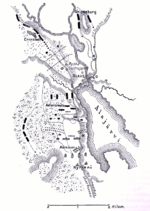Battle of Alavus
This article includes a list of general references, but it lacks sufficient corresponding inline citations. (September 2014) |
| Battle of Alavus | |
|---|---|
| Part of the Swedish Finland | |
| Result | Swedish victory |
12 guns[1]
8 guns[1]
The Battle of Alavus took place on 17 August 1808 in the vicinity of the town of
Prelude
With his
Probably encouraged by the victory at Kauhajoki, marshal Wilhelm Mauritz Klingspor ordered general Adlercreutz to attack the Russian position at Alavus. The army, much worn by the ordeals of the summer, was moved south on 16 August in pouring rain. The following day the weather cleared.
The battle

In bright sunshine, Adlercreutz attacked the Russian positions south of the Alavus
Aftermath
Despite the success, Klingspor never capitalized on it or the outcome of Lapua and the difficult Russian supply situation in the summer of 1808. After the defeat at Alavus, Russian fortune turned and Kamensky was successful in his counteroffensive, which drove the Swedes ever further north.
Citations and sources
Citations
- ^ a b c d Hornborg 1955, pp. 133–134.
Sources
- Finska kriget 1808–1809, ISBN 91-518-4101-0).
- Hornborg, Eirik (1955). När riket sprängdes: fälttågen i Finland och Västerbotten, 1808–1809 (in Swedish). Stockholm: P. A. Norstedts och Söners Förlag.
62°35′11″N 23°36′57″E / 62.58639°N 23.61583°E
